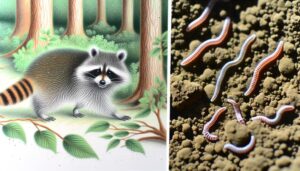Do Raccoons and Skunks Live Together: A Homeowner’s Guide
Yes, raccoons and skunks can live in overlapping territories, particularly in urban areas. Both species are nocturnal and exhibit dietary flexibility, helping them coexist without direct competition.
Raccoons are more social, while skunks are generally solitary. Their distinct foraging habits and undemanding shelter requirements give them the ability to share environments.
Adaptations such as skunks' defensive spray and raccoons' dexterous foraging help minimize conflicts. Observing their interactions reveals ecological benefits like pest control and seed dispersal.
Exploring their behavior and adaptations provides deeper insights into their effective coexistence strategies.
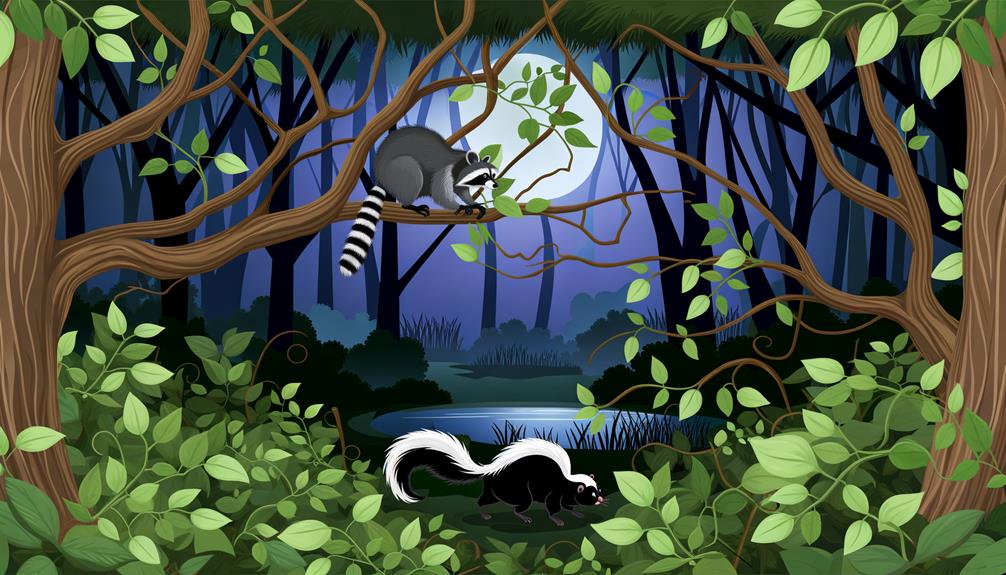
Key Takeaways
- Raccoons and skunks can coexist in overlapping territories, especially in urban environments with abundant food sources.
- Both species exhibit nocturnal behavior, reducing direct competition and facilitating coexistence.
- Raccoons are more social, while skunks are solitary, minimizing conflicts between them.
- Adaptations in foraging strategies and microhabitat preferences help raccoons and skunks avoid direct competition.
- Their coexistence benefits ecosystems by enhancing pest control and promoting plant biodiversity.
Understanding Raccoon Behavior

Raccoons (Procyon lotor) exhibit a range of complex behaviors that are essential for their survival, including foraging strategies, social interactions, and nesting habits.
Their foraging behavior is characterized by a high degree of adaptability, allowing them to exploit a diverse array of food sources ranging from fruits and nuts to small vertebrates and human refuse.
Socially, raccoons are generally solitary but exhibit flexible social structures, sometimes forming mother-offspring groups or temporary foraging alliances.
Nesting habits involve selecting secure, elevated locations such as tree cavities or abandoned structures to provide protection from predators and harsh weather conditions.
These behaviors collectively enhance their ability to thrive in various environments, from wild forests to urban areas, underscoring their remarkable ecological versatility.
Understanding Skunk Behavior
Skunks exhibit distinct nocturnal activity patterns, primarily emerging under the cover of darkness to forage.
Their well-known defensive spray mechanism serves as a potent deterrent against potential predators.
Additionally, skunks have varied foraging and diet preferences, often consuming a mix of insects, small mammals, fruits, and vegetation.
Nocturnal Activity Patterns
Nocturnal activity patterns in skunks are characterized by a distinct preference for foraging and social interactions during nighttime hours, driven by their crepuscular and nocturnal nature. These activity patterns are essential for understanding skunk behavior, as they optimize their foraging efficiency and minimize encounters with predators. Skunks typically emerge at dusk, engaging in a variety of behaviors including hunting for insects, small mammals, and plant matter. The following table provides a detailed breakdown of their nocturnal activities:
| Time of Night | Primary Activities |
|---|---|
| Dusk | Emergence, initial foraging |
| Early Night | Active foraging, social interactions |
| Midnight | Peak foraging activity |
| Pre-Dawn | Return to dens, resting |
Understanding these patterns helps in appreciating the ecological role and behavioral adaptations of skunks.
Defensive Spray Mechanism
Due to their unique anatomical adaptations, skunks possess a highly effective defensive spray mechanism that serves as a primary deterrent against potential predators. This mechanism involves specialized anal glands that produce a sulfur-containing compound known as thiols.
When threatened, skunks can accurately spray this noxious substance up to 10 feet, temporarily blinding and disorienting their aggressor. The compound's pungent odor is not only irritating but also lingers on surfaces and in the air, enhancing its deterrent efficacy.
Prior to spraying, skunks often exhibit warning behaviors such as stomping their feet and raising their tails, providing a vital opportunity for the threat to retreat. This highly evolved defense minimizes physical confrontations and conserves energy for the skunk.
Foraging and Diet Preferences
Understanding skunk behavior necessitates examining their foraging habits and dietary preferences, which are as distinctive and adaptive as their defensive mechanisms.
Skunks are omnivorous, displaying dietary flexibility that includes insects, small mammals, fruits, and vegetation. Their foraging behavior is mainly nocturnal, utilizing their keen sense of smell to locate food.
During warmer months, skunks primarily consume insects, which provide essential proteins and fats. In contrast, winter diets shift towards plant matter and available small prey. This adaptability allows skunks to thrive in diverse habitats, from urban areas to rural landscapes.
Such dietary versatility not only supports their survival but also minimizes direct competition with other nocturnal foragers like raccoons, facilitating cohabitation in overlapping territories.
Habitat Preferences
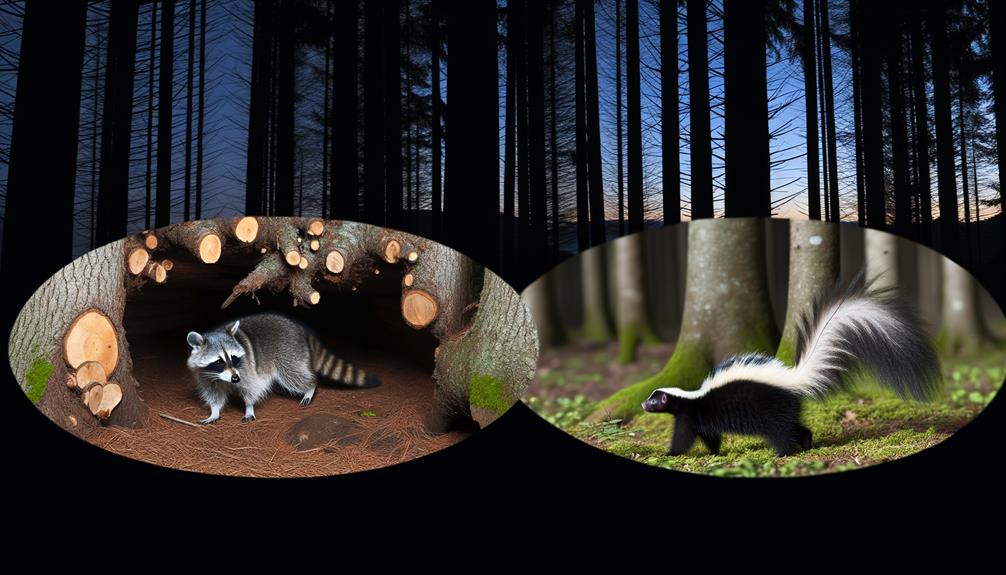
Raccoons and skunks exhibit distinct preferences for habitats that cater to their specific needs, including urban and rural areas.
Their choice of shelter and nesting sites is influenced by the availability of secluded spaces, while access to consistent food and water sources is paramount for their survival.
Understanding these habitat preferences is essential for comprehending how these species coexist and interact within shared environments.
Urban Vs. Rural Areas
Habitat preferences for raccoons and skunks can vary significantly between urban and rural areas, influenced by factors such as food availability, shelter options, and human activity levels. In urban environments, raccoons and skunks often exploit readily available food sources, including garbage and pet food, while rural areas provide more natural foraging opportunities such as insects and small vertebrates. Human activity also affects their behavior; urban settings may require nocturnal activity to avoid human interaction, whereas rural areas allow for more flexible activity patterns.
| Factor | Urban Areas | Rural Areas |
|---|---|---|
| Food Availability | Garbage, pet food | Natural foraging |
| Shelter Options | Buildings, crawl spaces | Forests, burrows |
| Human Activity Level | High, requiring nocturnal behavior | Lower, allowing flexible patterns |
Understanding these differences is essential for wildlife management and conservation efforts.
Shelter and Nesting Sites
While food availability and human activity shape the behavior of raccoons and skunks, the selection of shelter and nesting sites further delineates their habitat preferences in urban and rural settings. Raccoons often choose hollow trees, abandoned burrows, and attics, demonstrating a preference for elevated or enclosed spaces that offer protection.
Skunks, on the other hand, favor ground-level dens such as abandoned animal burrows, under decks, or in dense vegetation. These preferences highlight skunks' need for easily accessible shelters. Both species are adaptable, yet their distinct nesting choices reduce direct competition for space.
In urban areas, their overlapping habitats increase encounters, though their differing shelter preferences mitigate potential conflicts, allowing cohabitation with minimal interaction.
Food and Water Sources
Understanding the food and water sources that raccoons and skunks rely on is vital for comprehending their habitat preferences and coexistence dynamics. Both species are omnivorous, consuming a diverse diet that includes fruits, insects, small mammals, and human food waste.
Raccoons are adept at foraging in water, often hunting for aquatic prey such as crayfish and amphibians, whereas skunks typically forage on land, focusing on ground-dwelling insects and small vertebrates. Access to reliable water sources, such as rivers, lakes, or urban water supplies, is pivotal for both species.
The overlap in diet and water requirements facilitates their coexistence in shared habitats, especially in suburban and urban environments where food and water resources are abundant and easily accessible.
Feeding Habits
How do raccoons and skunks adapt their feeding habits when cohabiting the same environment? Both species exhibit opportunistic feeding behaviors, allowing them to exploit a variety of food sources. Raccoons, with skilled forepaws, can access a wider range of items, including fruits, insects, and small vertebrates. Skunks, mainly insect-eating, utilize their sharp sense of smell to locate grubs, insects, and small rodents. When sharing habitats, their feeding niches may overlap, yet they tend to avoid direct competition through temporal separation and dietary specialization.
| Species | Primary Diet | Feeding Adaptation |
|---|---|---|
| Raccoon | Omnivorous | Skilled forepaws |
| Skunk | Insectivorous | Sharp sense of smell |
| Both | Opportunistic | Temporal separation |
This adaptive flexibility guarantees both species can thrive without significant dietary conflict.
Nocturnal Activities
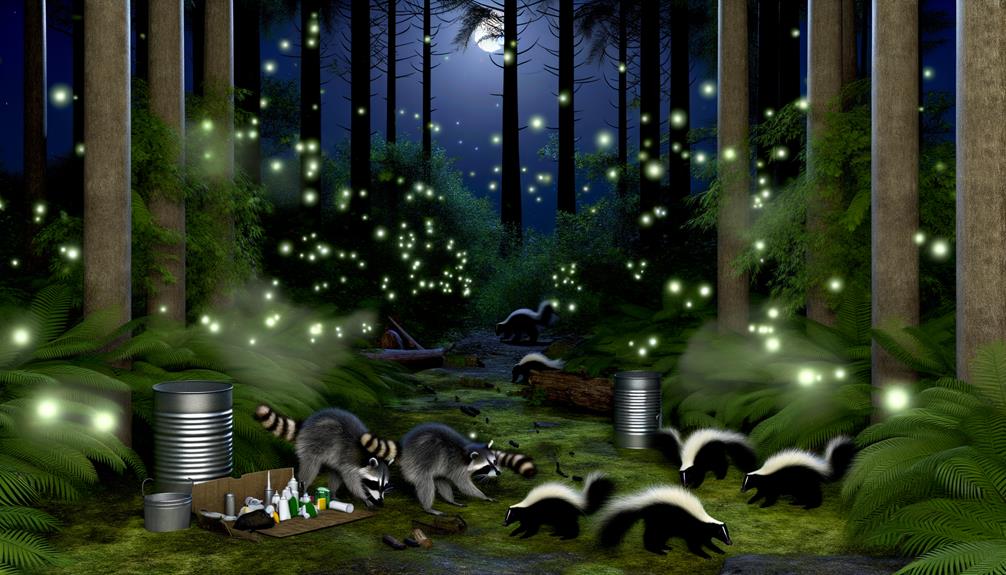
Raccoons and skunks exhibit distinct yet overlapping nocturnal activities, primarily characterized by their hunting and foraging patterns. Both species navigate interactions with predators through various adaptive behaviors, while their territorial overlap is often timed to minimize direct competition.
Detailed observation of their nocturnal activities provides insights into the ecological dynamics of their coexistence.
Hunting and Foraging Patterns
Both raccoons and skunks exhibit distinct nocturnal hunting and foraging behaviors, often influenced by their ecological niches and physiological adaptations. Raccoons are omnivorous, opportunistic feeders, employing their dexterous front paws to forage a variety of food sources, including fruits, insects, and small vertebrates. Skunks, primarily insectivores, utilize their keen sense of smell to locate grubs, insects, and small mammals. The nocturnal activities of these species minimize competition and predation, allowing them to exploit food resources effectively.
| Species | Primary Diet | Foraging Technique |
|---|---|---|
| Raccoon | Omnivorous | Dexterous front paws |
| Skunk | Primarily insectivorous | Keen sense of smell |
These behavioral patterns underscore their adaptations to nocturnal life, enhancing their survival and resource acquisition.
Interaction With Predators
Nocturnal activities of raccoons and skunks are strategically adapted to mitigate the risk of predation, leveraging their sensory capabilities and environmental awareness. These animals employ several tactics to enhance their survival during nighttime foraging and movement.
- Heightened senses: Both species have acute night vision and a strong sense of smell, aiding in the detection of predators.
- Stealthy movement: They move quietly and cautiously to avoid drawing attention to themselves.
- Use of cover: They utilize natural cover such as dense vegetation and structures to remain concealed from predators.
- Warning mechanisms: Skunks possess a potent defense mechanism in their spray, while raccoons rely on their agility to escape threats.
These behaviors collectively contribute to their nocturnal survival strategies.
Territorial Overlap Timing
Territorial overlap between raccoons and skunks during their nocturnal activities is influenced by the availability of resources and habitat structures, necessitating a complex interplay of spatial and temporal behaviors to minimize direct competition.
Both species are nocturnal, foraging primarily at night, which can lead to potential conflicts. However, their foraging strategies differ; raccoons are more omnivorous and adaptable, while skunks focus on insects and small vertebrates. This dietary differentiation reduces direct competition.
Additionally, raccoons and skunks may utilize different microhabitats within the same area, further minimizing overlap. Temporal partitioning also occurs, with one species foraging earlier in the night and the other later, thereby reducing interactions and allowing coexistence within overlapping territories.
Social Structures
Understanding the social structures of raccoons and skunks requires a detailed examination of their interaction patterns, territorial behaviors, and communication methods. Raccoons are generally solitary but may exhibit social behaviors during breeding seasons or when food resources are abundant.
Skunks, on the other hand, typically maintain solitary lifestyles, with limited social interaction outside of mating periods and maternal care.
Key differences in their social structures include:
- Territoriality: Raccoons exhibit defined territories that may overlap slightly, whereas skunks are highly territorial with minimal overlap.
- Communication: Raccoons use a variety of vocalizations and body language, while skunks rely primarily on scent marking.
- Group Dynamics: Raccoons occasionally form small, temporary groups; skunks rarely do.
- Breeding Behavior: Both species are solitary breeders but differ in courtship and maternal care strategies.
Interaction in the Wild
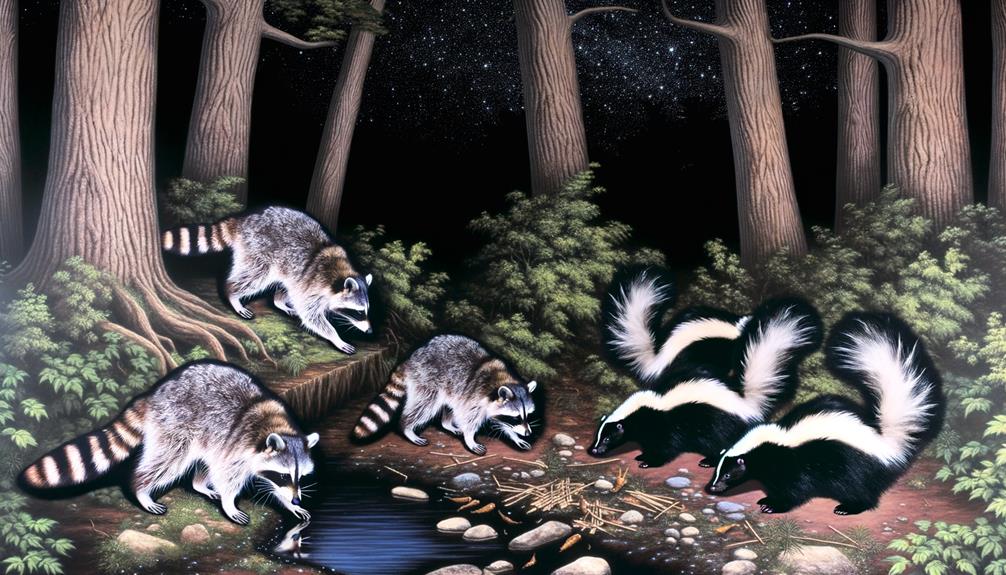
Examining the interactions between raccoons and skunks in the wild reveals complex dynamics shaped by their respective social structures and environmental factors. Both species exhibit primarily solitary behaviors, yet they may occasionally cross paths due to overlapping habitats. Their interactions are largely characterized by avoidance, driven by the need to minimize conflict and competition for resources.
| Factor | Impact on Interaction |
|---|---|
| Foraging Behavior | Both are nocturnal foragers, often leading to indirect competition. |
| Habitat Preference | Overlapping habitats increase encounter probabilities. |
| Social Structure | Solitary nature reduces direct confrontations. |
These dynamics underscore an intricate balance where mutual avoidance serves as a key strategy, allowing raccoons and skunks to coexist without significant conflict.
Urban Environment Adaptation
As urbanization encroaches upon natural habitats, raccoons and skunks exhibit remarkable adaptability, altering their behaviors and foraging strategies to thrive in metropolitan environments. These animals exploit urban resources efficiently, leading to notable shifts in their ecological patterns.
- Food Sources: Raccoons and skunks utilize human waste, pet food, and garden produce, broadening their dietary options.
- Shelter: Both species find refuge in man-made structures such as attics, basements, and garages.
- Activity Patterns: Increased nocturnal activity helps avoid human interactions and take advantage of quieter urban nights.
- Social Dynamics: Urban settings might alter the traditional solitary nature of these species due to the abundance of resources.
Understanding these adaptations is essential for effective urban wildlife management.
Potential Conflicts
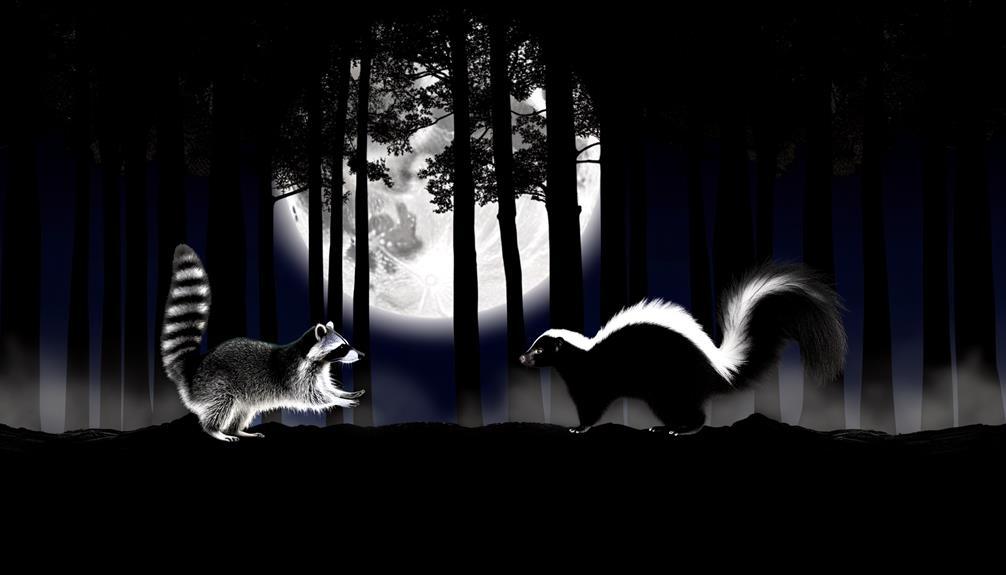
The proximity of raccoons and skunks to human dwellings in urban areas often leads to conflicts, including property damage, health concerns, and disruptions to local ecosystems.
Raccoons are known for their dexterity and can cause significant damage by rummaging through garbage bins or entering attics and basements. Skunks, while less invasive, pose a risk through their defensive sprays, which can be both a nuisance and a health hazard.
Both species are potential carriers of zoonotic diseases such as rabies and leptospirosis, posing a threat to pets and humans. Additionally, their foraging behaviors can disrupt local fauna and flora, leading to imbalances in urban ecosystems.
Effective management strategies are essential to mitigate these conflicts.
Benefits of Coexistence
Coexisting populations of raccoons and skunks can contribute to urban biodiversity by playing distinct ecological roles that aid in pest control and seed dispersal. Raccoons, being omnivorous, consume a variety of pests such as insects and small rodents, thereby helping to control these populations. Skunks, on the other hand, are known for their diet of harmful insects and larvae, contributing to natural pest management. Both species also play a role in seed dispersal through their varied diets, promoting plant diversity.
Benefits of coexistence include:
- Enhanced pest control: Reduction of insect and rodent populations.
- Seed dispersal: Promotes plant biodiversity and ecosystem health.
- Nutrient cycling: Decomposition of organic matter.
- Educational value: Opportunities for urban residents to learn about local wildlife.
Observations and Studies

In recent studies, researchers have meticulously documented the interactions between raccoons and skunks in urban environments, providing valuable insights into their behavioral patterns and ecological impacts. Through systematic observation and data collection, scientists have noted that both species often inhabit overlapping territories, particularly in areas with abundant food resources.
These studies reveal that while raccoons and skunks may occasionally compete for food, their interactions are generally non-aggressive, suggesting a form of passive coexistence. Additionally, the presence of both species in urban settings has been linked to increased biodiversity and changes in local food web dynamics.
Such findings underscore the importance of understanding interspecies relationships in developing effective urban wildlife management strategies.
Conclusion
Raccoons and skunks, while sharing similar nocturnal and omnivorous behaviors, display distinct differences in habitat preferences and feeding habits.
Their adaptation to urban environments underscores their ecological flexibility.
Potential conflicts arise from competition for resources, but these can be mitigated by the benefits of coexistence, such as mutual deterrence of predators.
Observational studies suggest that while cohabitation occurs, it remains a delicate balance, intricately influenced by environmental factors and species-specific behaviors.


